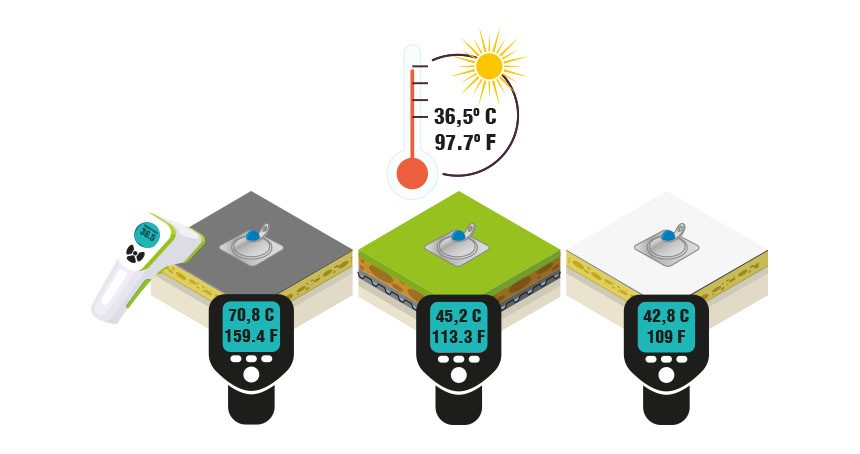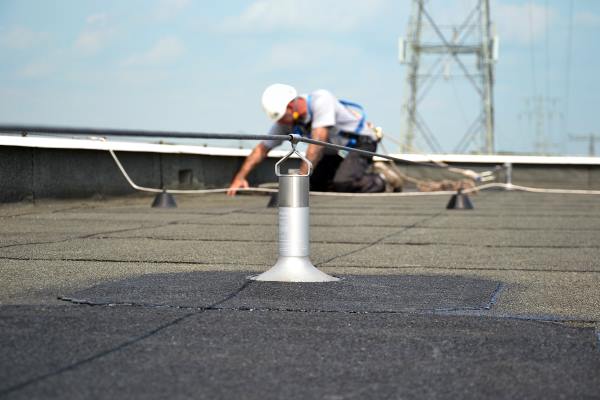
It’s the middle of summer, weather’s nice and the workday looks prosperous at first. The fact that it is nice and warm is not an automatic indication that it is dangerous to work in. The sun is mercilessly bright and in an open, unshaded environment you have to take this into account. The risk of sunstroke is very high because its effects have already taken effect before the victim has noticed it them self. When working along roof edges, there is also a real danger of falling!
Roofs mostly consist of dark materials that converts sunlight into heat. It attracts and retains heat as well. When the job at height is time-consuming, it becomes difficult to keep exposure to this heat as short as possible. With prolonged exposure, you risk suffering from 2 heat forms:
1. Heat build-up
This is a combination of exertion and wearing clothing that causes the body temperature to rise rapidly. This form of heat often begins with intense sweating and a decrease in concentration.
Because muscles become too warm inside they will protest, which will hinder your work. Muscle twitching in the arms and legs can be the painful result of rapid fluid loss.
The mildest form of heat discomfort is heat rash, not so much from the heat itself but from prolonged perspiration. Sweat glands become blocked resulting in itchy and/or burning blisters.
Things get more serious if you suffer from heat exhaustion. Heat exhaustion is insidious because it occurs only upon cessation of exercise. Your blood pressure has been disrupted as your body strains to keep the vital organs supplied with blood. When this effort is reduced, your blood pressure suddenly drops very quickly. You will become unwell, suffer from headaches, dizziness, and have an unsteady walk. Tripping and falling hazards are lurking around the corner.
Heat exhaustion can eventually degenerate into heat stroke: the most serious and deadly form of heat exhaustion. When your body temperature exceeds 41 C° (105.80 ℉), your nerve system becomes damaged, sometimes permanently. You can recognize a heatstroke by cramps, convulsions, confused behavior and eventually loss of consciousness.

2. Heat Radiation
Roofing material such as bitumen is dark in color and transforms light to heat. When the temperature outside is 36.5 C° (97.7 °F) degrees, the temperature of bitumen becomes as much as 70.8 C° (159.44 °F), more than twice as much as the outside temperature at that time. You can already burn your body quite a bit on this.
The mildest form is sunburn, the red glow on the skin when exposed to the sun for a long period of wearing sunscreen. It is not only very painful and uncomfortable but also life-threatening. A burnt skin caused by heat radiation significantly increases the risk of skin cancer. Therefore, start your working day at altitude by applying sunscreen and repeat this with regular intervals.

Safety Measures in extreme heat
There may be no official rules for working in high temperatures. In that case, relying on your common sense is best indicator. You can ask yourself;
- Whether working in the heat is really necessary?
Can the work wait for more pleasant temperatures?
- Can the hours of work in the heat be reduced?
Is it a part-time task or work that takes all day? - Can the time of work during the day be adjusted?
The temperature in the morning is lower than in the afternoon. The maximum sun power and thus the heat is when the sun reaches its highest point.
Do you still want to get started? Then use the practical tips below:
Be prepared for what you are dealing with and understand the risks/dangers you are facing! To help employers and employees, we have created an infographic about the risks that can occur during heat. Print out this infographic and hang it somewhere everyone can see to keep safety on roofs top of mind.
A sunstroke usually starts with sunburn. If the skin is exposed to the bright sun for an extended period of time, it may be absorbing too much heat. Use enough sunscreen for body parts exposed to the sun. Preferably wear long pants and or long-sleeved shirt.
Despite good preparation, occasional breaks should be taken to go inside or seek shade. Hydrate and get some rest before work resumes.

Conclusion
Preferably work in pairs so you can keep an eye on each other. Listen to your body! Drink and eat enough and protect yourself with a good sunscreen. Avoid dehydration, the body works on fluids. It is important to be sufficiently hydrated for sun protection. Do not consume alcohol when working at height; save it for when the job is finished!
Be Prepared!
Know what to expect on roofs during high temperatures. To help employers and employees, we have created an infographic about the risks that can occur during heat. Print out this infographic and hang it up in a place that is visible to everyone to keep safety on roofs top of mind.
